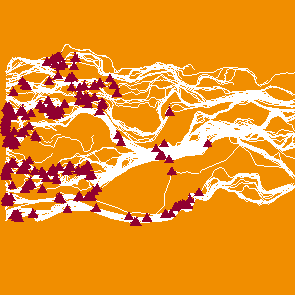Research Projets
Scientific context
-
Groundwater is an important part of drinking water as high as 63 % in France. It
also represents 96 % of the water intake points compared to 4 % for surface
water. Groundwater is highly dependent on the percentage of pores (porosity),
their size and connectivity (permeability) and on the biochemical reactivity.
These parameters (porosity, permeability, reactivity) are highly variable. In
sedimentary structures, the deposition modes of grains induce permeability to
shift over three to four orders of magnitude. In rocks, parallel fractures may
represent only 0.01 % of the volume although they are the sole water carrying
structures. The geological complexity addresses a challenge for the management
of groundwater.
-
Fractures and heterogeneous sedimentary units cannot be identified whatever the
remote data. Because data give a rather scarce description of the hydraulic
properties, predictions rely heavily on modelling, and particularly on numerical
modelling. We underline that the physical phenomenon is not complex in itself
but both the broad geological heterogeneity and the lack of observations require
dealing with uncertainty. In this context, numerical modelling should integrate
the multi-scale geological heterogeneity, simulate the hydraulic flow and
transport phenomena and quantify uncertainty coming from the lack of data.
-
Analytical techniques like homogenization or perturbations are in general not
relevant. Modelling must thus be performed in a probabilistic framework that
transfers the lack of data on prediction variability. In this stochastic
approach, numerical simulations consist in computing the velocity field over
large spatial domains and solving solute transport over large temporal scales.
High performance computing is thus necessary to carry out these large scale
simulations.
Research topics
- The development of the platform H2OLAB is one workpackage of the ANR project
MICAS.
Other workpackages of MICAS include numerical models for flow and transport in porous and fractured media,
geophysical studies such as upscaling and macro-dispersion,
uncertainty quantification, domain decomposition methods, high performance computing.
- Research projects of the different partners can be found on their respective websites.
